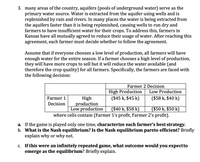
3. many areas of the country, aquifers (pools of underground water) serve as the primary water source. Water is extracted from the aquifer using wells and is replenished by rain and rivers. In many places the water is being extracted from the aquifers faster than it is being replenished, causing wells to run dry and farmers to have insufficient water for their crops. To address this, farmers in Kansas have all mutually agreed to reduce their usage of water. After reaching this agreement, each farmer must decide whether to follow the agreement.
Assume that if everyone chooses a low level of production, all farmers will have enough water for the entire season. If a farmer chooses a high level of production, they will have more crops to sell but it will reduce the water available (and therefore the crop quality) for all farmers. Specifically, the farmers are faced with the decision shown in the images.
a. If the game is played only one time, characterize each farmer’s best strategy.
b. What is the Nash equilibrium? Is the Nash equilibrium pareto efficient? Briefly explain why or why not.
c. If this were an infinitely repeated game, what outcome would you expect to emerge as the equilibrium? Briefly explain.

Trending nowThis is a popular solution!
Step by stepSolved in 4 steps

- o ensure all students are protected from getting the flu this year, your school offers free flu shots. What type of externality exists in this example? Question 16 options: Negative consumption externality. Negative production externality. Positive production externality. Positive consumption externality. Neutral externality.arrow_forwardWhat might happen to alligators in the south if the U.S. Fish and Wildlife Service were to reduce or eliminate the tags required to hunt alligators?arrow_forwardHand written solutions are strictly prohibitedarrow_forward
- I Price and cost (thousands of dollars per student) 20 16 12 8 0 200 A) 0 students; 400 students B) 600 students; 600 students C) 400 students; 600 students D) 600 students; 400 students E) 400 students; 400 students S = MC MSB MB 400 600 800 1,000 Quantity (students per year) 35) 35) The figure above shows the market for private elementary school education in Chicago. There is no external cost of private elementary education. If the government does not intervene in this market, the equilibrium number of students being privately educated is and the efficient quantity isarrow_forward1arrow_forwardThe marginal private cost of fertilizer production is MPC = 40 + Q, where Q is the amount of fertilizer produced. The marginal benefit (both private and social) of fertilizer is MB = 340 – 4Q. In addition to the private costs faced by producers of fertilizer, people who walk or drive past the area where the fertilizer is produced also face costs because of the horrible smell of the fertilizer; the marginal external cost generated by the fertilizer is MEC = 20 + 3Q. How much fertilizer will be produced by the free market? What is the efficient quantity of fertilizer? Calculate the amount of deadweight loss in this market, and explain what this number means. Suppose that the government realizes that the current amount of fertilizer produced by the free market is inefficient and decides to correct this inefficiency by taxing the production of fertilizer. How large should the tax per unit of fertilizer be to induce the market to produce the efficient amount, and why would such a tax…arrow_forward
- A village has six residents, each of whom has accumulated savings of $100. Each villager can use this money either to buy a government bond that pays 14 percent interest per year or to buy a year-old llama, send it onto the commons to graze, and sell it after 1 year. The price the villager gets for the 2-year-old llama depends on the quality of the fleece it grows while grazing on the commons. That in turn depends on the animal’s access to grazing, which depends on the number of llamas sent to the commons, as shown in the following table: Number of llamas on the commons Price per 2-year-old llama ($) 1 125 2 119 3 116 4 113 5 111 6 109 The villagers make their investment decisions one after another, and their decisions are public. a. If each villager decides individually how to invest, how many llamas will be sent onto the commons, and what will be the resulting village income?Number of llamas: Instructions: Enter your response as a whole number.Village income: $…arrow_forwardWhich one of the following is an example of demand-side water management? Group of answer choices A.Building large dams B. Desalination C. Increasing water prices D. Making more waterarrow_forward

 Principles of Economics (12th Edition)EconomicsISBN:9780134078779Author:Karl E. Case, Ray C. Fair, Sharon E. OsterPublisher:PEARSON
Principles of Economics (12th Edition)EconomicsISBN:9780134078779Author:Karl E. Case, Ray C. Fair, Sharon E. OsterPublisher:PEARSON Engineering Economy (17th Edition)EconomicsISBN:9780134870069Author:William G. Sullivan, Elin M. Wicks, C. Patrick KoellingPublisher:PEARSON
Engineering Economy (17th Edition)EconomicsISBN:9780134870069Author:William G. Sullivan, Elin M. Wicks, C. Patrick KoellingPublisher:PEARSON Principles of Economics (MindTap Course List)EconomicsISBN:9781305585126Author:N. Gregory MankiwPublisher:Cengage Learning
Principles of Economics (MindTap Course List)EconomicsISBN:9781305585126Author:N. Gregory MankiwPublisher:Cengage Learning Managerial Economics: A Problem Solving ApproachEconomicsISBN:9781337106665Author:Luke M. Froeb, Brian T. McCann, Michael R. Ward, Mike ShorPublisher:Cengage Learning
Managerial Economics: A Problem Solving ApproachEconomicsISBN:9781337106665Author:Luke M. Froeb, Brian T. McCann, Michael R. Ward, Mike ShorPublisher:Cengage Learning Managerial Economics & Business Strategy (Mcgraw-...EconomicsISBN:9781259290619Author:Michael Baye, Jeff PrincePublisher:McGraw-Hill Education
Managerial Economics & Business Strategy (Mcgraw-...EconomicsISBN:9781259290619Author:Michael Baye, Jeff PrincePublisher:McGraw-Hill Education





